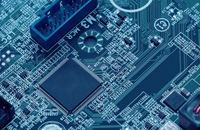Piezoelectric energy harvester in wearable device
A wearable device that can generate enough power to run a personal health monitoring system through body movements alone, has been created by a team of researchers from Penn State's Materials Research Institute and the University of Utah.

"The devices we make using our optimised materials run somewhere between 5 and 50 times better than anything else that's been reported," said Professor Susan Trolier-McKinstry of Penn State.
Prof. Trolier-McKinstry and her former doctoral student, Hong Goo Yeo, used the piezoelectric material known as PZT; coating it on both sides of a flexible metal foil to a thickness four or five times greater than in previous devices. Greater volume of the active material equates to generation of more power. By orienting the film's crystal structure to optimise polarisation, the performance - known as the figure of merit - of energy harvesting was increased. The compressive stresses that are created in the film as it is grown on the flexible metal foils also means that the PZT films can sustain high strains without cracking, making for more robust devices.
"There were some good materials science challenges," Prof. Trolier-McKinstry said. "The first was how to get the film thickness high on a flexible metal foil. Then we needed to get the proper crystal orientation in order to get the strongest piezoelectric effect."
Collaborators at the University of Utah and in Penn State's Department of Mechanical Engineering designed a wristwatch-like device that incorporates the PZT/metal foil materials. The device uses a freely rotating, eccentric brass rotor with a magnet embedded, and multiple PZT beams with a magnet on each beam. When the magnet on the rotor approaches one of the beams, the magnets repel each other and deflect the beam, plucking the beam in a process that is referred to as frequency up-conversion. The slow frequency of a rotating wrist is converted into a higher frequency oscillation. The design of this device is more efficient than a standard electromagnetic harvester - like those used in self-powered watches - according to Prof. Trolier-McKinstry.
In future work, the team believes they can double the power output using the cold sintering process, a low-temperature synthesis technology developed at Penn State. In addition, the researchers are working on adding a magnetic component to the current mechanical harvester to scavenge energy over a larger portion of the day when there is no physical activity.
在线留言询价
- 一周热料
- 紧缺物料秒杀
| 型号 | 品牌 | 询价 |
|---|---|---|
| MC33074DR2G | onsemi | |
| RB751G-40T2R | ROHM Semiconductor | |
| BD71847AMWV-E2 | ROHM Semiconductor | |
| TL431ACLPR | Texas Instruments | |
| CDZVT2R20B | ROHM Semiconductor |
| 型号 | 品牌 | 抢购 |
|---|---|---|
| IPZ40N04S5L4R8ATMA1 | Infineon Technologies | |
| BU33JA2MNVX-CTL | ROHM Semiconductor | |
| STM32F429IGT6 | STMicroelectronics | |
| BP3621 | ROHM Semiconductor | |
| TPS63050YFFR | Texas Instruments | |
| ESR03EZPJ151 | ROHM Semiconductor |
- 周排行榜
- 月排行榜
AMEYA360公众号二维码
识别二维码,即可关注
























